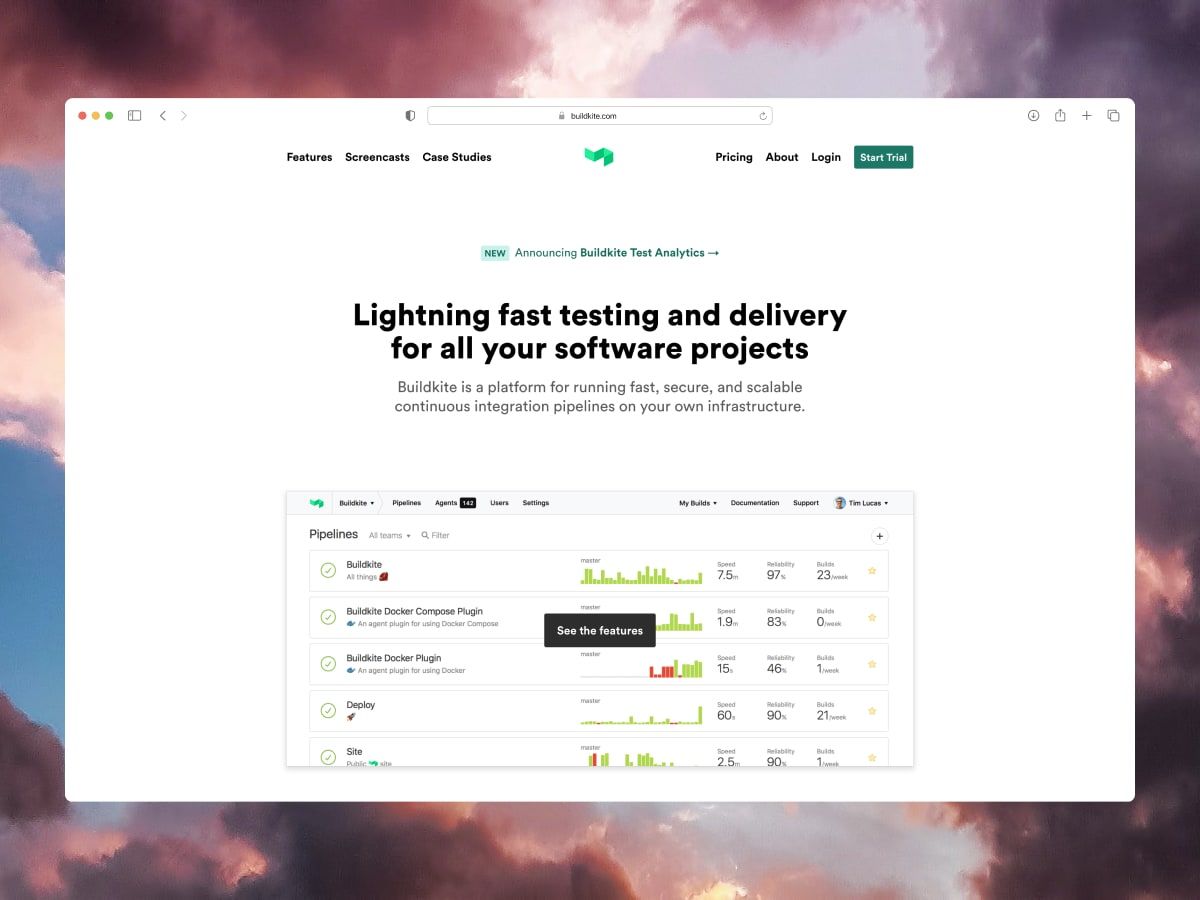Looking for a remote job so you can work from home? Good news! Finding a remote job has never been easier.
This article outlines where to find remote jobs, how to decide if remote work is right for you, how to stand out in the hiring process, and how to stay productive once you’re hired.

Where to find remote jobs
The best way to find remote jobs is through remote job boards. Remote job boards focus on remote opportunities and have features that make it easy to find relevant remote roles. For example, many remote jobs require you to live in specific time zones or countries, so the best remote job sites have time zone and visa-based filtering.
We’ve done an extensive search for the best remote job boards but here are our top five:

1. Himalayas
Himalayas is the best website for job seekers to find relevant remote roles. We have over 1,500 remote job openings and add the best new jobs daily.
Our job search is fast, efficient, and beautifully designed with the remote job seeker in mind. You can filter by visa and time zone requirements, as well as company, salary range, and job type.
We also have over 1,700 remote company profiles that make it easy to find companies whose culture and mission match your values, experience, and needs. Each profile outlines what the company does and its tech stack, employee benefits, and open remote roles.
Best of all, Himalayas is 100% free for job seekers.
Find a remote job on Himalayas today.

2. FlexJobs
FlexJobs is a flexible and remote job board that has been helping job seekers “have a faster, easier, and safer job search” since 2007. It offers one of the largest selections of remote job listings with more than 20,000 jobs across 50+ categories.
The downside is that it costs a recurring $24.95 per month.

3. Remote OK
Remote OK is another popular remote job board created by Nomad List founder Pieter Levels in 2015. Due to its reach, it’s one of the best places to find remote job opportunities. It also has a handy filter to find “only worldwide jobs” that will hire you from anywhere.

4. We Work Remotely
We Work Remotely is a large remote job board claiming over 3 million visitors per month. WWR was founded in 2011 and offers hundreds of remote jobs across the world.
They recently improved their job search experience by allowing job seekers to filter jobs by keywords, job categories, companies, and time zones.

5. Remotive
Remotive is a remote job board, community, and newsletter that was founded by Rodolphe Dutel in 2014. Remotive has over a thousand open remote job postings and 14,000+ remote company profiles that their team screens to ensure they’re remote.
Jobs clearly display location restraints which makes it easier to find relevant remote work opportunities.

Companies hiring remote employees
There have never been more companies supporting remote work. However, it’s essential to understand there are different levels of remote, and each offers different pros and cons.
Hybrid companies have at least one physical location while allowing employees to work from home regularly. Some hybrid companies will even let you work remotely permanently, but most require you to live within commuting distance of the office and to come in consistently.
Then there are remote-friendly companies, which are hybrid companies that support full-time remote workers. At remote-friendly companies, employees typically must live in the same country or have significant working hours overlap with the physical office. For example, the office may be in San Francisco and allow staff to work remotely from anywhere in America or Canada.
Fully-remote companies have no physical office and a fully remote employee base. Like remote-friendly companies, you may be required to live in specific countries or time zones.
Finally, there are remote-first companies that have been remote from day one. Remote-first companies tend to have greater flexibility in living location because they rely on asynchronous communication and written documentation to collaborate.
You can learn more about remote-first versus remote-friendly companies here.

Even if you find that a remote company you’re passionate about doesn’t have any open remote roles, reach out and see if they’re interested in you based on your skills and experience.
The best way to do this is to direct message the manager of the functional area you want to work in on Twitter or LinkedIn. Finding the relevant person on social media shows your resourcefulness and deep interest in the company, which is sure to make you stand out.
We recommend starting your search by reviewing these lists:
- 1,700+ remote companies: Each profile has information about the company, any open remote roles, its tech stack, and employee benefits and perks.
- 125+ fully remote companies: These companies have committed to permanent remote work and don’t have physical offices. Many have employees spread across the globe and are unrestricted by time zones or country.
Below are a few of our favorite fully remote companies.

Automattic
Automattic is a fully remote company with more than 1,800 employees across 91 countries who speak 115+ different languages. They’re behind WordPress, WooCommerce, Jetpack, Tumblr, and have been 100% remote since 2005!
Learn about Automattic, Automattic’s tech stack, Automattic employee benefits, or find remote jobs at Automattic.

Basecamp
Basecamp builds an all-in-one toolkit for working remotely. Like Automattic, Basecamp has been pioneering remote work since they were founded in 2005. They literally wrote the book on remote work.
Learn about Basecamp, Basecamp’s tech stack, Basecamp employee benefits, or find remote jobs at Basecamp.

Buffer
Buffer builds a social media toolkit for more than 73,000 customers that drives meaningful engagement and results. Founded in 2010, Buffer has an 85+ fully distributed team living and working in 15 countries around the world.
Learn about Buffer, Buffer’s tech stack, Buffer employee benefits, or find remote jobs at Buffer.

Buildkite
Buildkite is a platform for running fast, secure, and continuous integration pipelines on your own infrastructure. Founded in 2014 in Melbourne, Australia, Buildkite is globally distributed, remote-first, and all its work happens over chat and video calls.
Learn about Buildkite, Buildkite’s tech stack, Buildkite employee benefits, or find remote jobs at Buildkite.

ConvertKit
ConvertKit builds a creator marketing platform that helps you connect with your fans, foster your community, and earn a living online. ConvertKit is 100% independent, 100% remote, and growing rapidly with more than 39k+ customers sending hundreds of millions of emails per month.
Learn about ConvertKit, ConvertKit's tech stack, ConvertKit employee benefits, or find remote jobs at ConvertKit.

Customer.io
Customer.io is an automated messaging platform for marketers who want more control and flexibility to craft and send data-driven messages. Founded in 2012, they’re a globally distributed, remote-first team of 157+ people in 34 countries that values synchronous and asynchronous work.
Learn about Customer.io, Customer.io’s tech stack, Customer.io employee benefits, or find remote jobs at Customer.io.

Doist
Doist makes productivity software for individuals and teams, namely Todoist and Twist. Doist is a remote-first team of 93 people representing 41 nationalities in 39 countries and 75 cities. Doist is clearly doing something right, with an incredible employee retention rate of 98.5%, and more than 50% of employees staying with the company for over four years.
Learn about Doist, Doist’s tech stack, Doist employee benefits or find remote jobs at Doist.

Float
Float is a resource management platform that gives teams an accurate view of their capacity, so they can plan, track, and optimize their work. Founded in 2012, Float is 100% self-funded and 100% remote with a team of 30+ folks working async across 20+ cities globally.
Learn about Float, Float’s tech stack, Float employee benefits, or find remote jobs at Float.

Ghost
Ghost lets you create your own platform on the web. It’s a powerful app to publish, share, and grow a business around content. Ghost was founded in April 2013 after a very successful Kickstarter campaign to create a platform focused on professional publishing. It’s a self-funded, open-source, non-profit with more than 12.7k customers. The team is fully remote spread across five continents.
Learn about Ghost, Ghost’s tech stack, Ghost employee benefits, or find remote jobs at Ghost.

GitLab
GitLab is one of the largest fully remote companies with more than 1,400 staff in 79 countries. GitLab’s DevOps platform is hyper-successful and the company is listed on the Nasdaq. They’re advocates for remote and asynchronous work and have played a huge role by showing it works at scale.
Learn about Gitlab, Gitlab’s tech stack, GitLab employee benefits, or find remote jobs at Gitlab.

Gumroad
Gumroad helps people earn a living online. They’ve sent over $500 million to creators on their platform and have 48 people scattered all over the world. Most staff work part-time, working on average 22 hours per week.
Learn about Gumroad, Gumroad’s tech stack, Gumroad employee benefits, or find remote jobs at Gumroad.

Help Scout
Help Scout builds a popular customer support email and live chat platform that helps “empower businesses with tools that serve people in the most human, helpful way.” Founded in 2011, Help Scout has been a fully remote company from day 1 and is powering 12,000+ teams in 140+ countries. Their 150+ distributed team is spread across 80+ cities worldwide.
Learn about Help Scout, Help Scout’s tech stack, Help Scout employee benefits, or find remote jobs at Help Scout.

Hotjar
Hotjar is a powerful user analytics and behavior tool that helps companies improve their website and convert more visitors. Hotjar is a 100% remote company and 100% self-funded. Today, they employ over 200 remote workers throughout the Americas, Europe, Africa, and Asia.
Learn about Hotjar, Hotjar’s tech stack, Hotjar employee benefits, or find remote jobs at Hotjar.

VEED
VEED is an online video editing platform that makes creating videos easy and accessible to all. Their platform is used by millions of creators around the world to tell stories, create content, grow audiences, and more. Founded in 2018, VEED bootstrapped millions in revenue before raising a $35 million Series A from Sequoia.
Learn about VEED, VEED’s tech stack, VEED employee benefits, or find remote jobs at VEED.

Whimsical
Whimsical is a collaboration tool designed to be a “unified workspace for thinking and collaboration.” Founded in 2017 in Denver, Colorado, Whimsical is a small fully remote team and growing fast, but they care deeply about doing things the right way.
Learn about Whimsical, Whimsical’s tech stack, Whimsical employee benefits, or find remote jobs at Whimsical.

Zapier
Zapier is a 100% distributed team on a mission to make automation incredibly easy and accessible for everyone at work. With Zapier, you can integrate thousands of apps together, so you can focus on your most important work. Zapier is one of the largest fully remote companies with 600+ employees spread across 17 time zones.
Learn about Zapier, Zapier’s tech stack, Zapier employee benefits, or find remote jobs at Zapier.

Best remote jobs and industries
Popular remote jobs: Developers, software engineering, sales, customer service, product management, user research, marketing, design, product designers, and finance.
Popular industries for remote companies: SaaS, marketplaces, enterprise software, eCommerce, software, blockchain, cryptocurrency, web3, fintech, financial services, and education.

How to decide if remote work is right for you
Before you start applying for remote positions, it’s important to decide whether remote work is right for you.
1. Understand the difference between working from home and working remotely
Many people conflate working from home with truly remote roles. In practice, the two are vastly different. Working from home lets you skip the commute to the office occasionally but requires you to live within commuting distance of the office. You can still head into the office when you want company and you can stay at home when you need to focus.
In contrast, working remotely means you never commute and in some cases, you may be able to work whenever and wherever you want. Some people even live as digital nomads, working and traveling at the same time. However, most companies require you to work in specific geographies or time zones to allow for real-time collaboration and to avoid compliance issues.
In general, remote work is a working style that lets you work outside the traditional office environment based on the idea that work doesn't need to be done from a specific place.
If you want to skip the commute occasionally, ask to work from home. If you want more location independence then it makes sense to look for a remote role.

2. Determine if you’re suited for remote work
Ask yourself the following questions to determine if you’re suited for remote work:
- Can I self-direct? Working remotely requires self-discipline. You can’t get away with only looking busy when you’re remote. Your performance will be judged based solely on your outputs, not your appearance. Remote work can also be full of distractions, so you need to be able to maintain focus without external help. This is why working at a company whose mission and values match your own is so important.
- Am I comfortable working alone? Unless you work in a co-working space, working remotely can be lonely. If you work at a fully remote company that works across time zones, you could be the only person working for most of your day. It’s best to have a strong social circle or hobbies outside of work that you can lean on.
- Are my communication skills strong? Working remotely requires excellent communication skills, particularly written if you are working in an asynchronous environment. When writing, you can’t rely on body language or tone to get your message across, so you need to have a strong command of the language you use day-to-day.
- Will I be capable of maintaining a healthy work-life balance? The most cited challenge of remote work is the inability to unplug from work. When you don’t commute, you lose the natural start and stop in your day causing many remote employees to struggle with overworking and burnout.
- Am I good at building and maintaining trust? It’s easy for trust issues to arise when you haven’t physically met someone. You’ll need to be transparent about what you’re working on, whether it’s working, and be comfortable asking for a helping hand to push things along.
- Can I fix my own technology problems? Remote work relies on technology that isn’t always perfect. Your modem might need to be reconfigured, your computer may need to be updated, or you might need to find replacement software on your own. Not to mention the information security risks.
- Will I be able to teach myself or actively seek out mentors? Remote work makes informal information sharing harder, so you often need to teach yourself things. It’s also hard to learn tribal knowledge and unspoken rules unless they are explicitly documented in a remote employee handbook. If you need help, it’ll be on you to ask.

3. Weigh up the pros and cons of remote work
Remote work can improve your work-life balance. As a remote worker, you’ll have more control over your schedule and can choose working hours that suit your needs. You’ll also save nearly ten days per year by not commuting and reduce your carbon footprint.
The time you save can be invested into improving your health by exercising, preparing healthy meals, or spending more time with the people you care about. However, remote work can also make it harder to unplug and cause you to live a sedentary lifestyle. When you stop commuting, you lose the natural start and stop in your workday which can lead to longer hours. You also lose any incidental exercise you did during your commute.
Remote work can also make you more or less productive. Study after study after study has shown remote workers are more productive than their in-office colleagues. But if you live in a busy home, working from home might be harder as distracting colleagues are quickly replaced by friends, family, children, or pets.

It can also be difficult to stay motivated. Particularly if you’re one of a few working remotely at a hybrid company. Working remotely when most people are in the office can even make career advancement more difficult because learning, mentorship, and tribal knowledge are harder to come by.
Working from home can be lonely. Hell might be other people, but isolation sure isn't heaven.
We all need social interaction to be happy. If you love catching up with your team in person, remote work might be difficult. It's hard to get everyone together for Friday night happy hour when you all live in different countries and time zones. With that said, off-sites can help but they're less frequent and harder to organize.
Communication and building relationships can also be more difficult. Communication issues are already abundant in a traditional office environment and compounded further in many remote environments. If you work from home while everyone else is in the office, you miss out on impromptu discussions and ad-hoc meetings.

While career advancement can be harder, remote workers also tend to have access to more job opportunities and can live in places with lower living costs. When your job search isn't bound by your ability to commute to the office, you can find a role that's perfect for you and live where you want.
You'll also save money in other ways. The average American commuter spends as much as $5,000 per year on their daily commute - including the cost of gas, maintenance costs, public transport, etc.
Not only can you save money, but you can also earn more money. There's a myth that remote workers are underpaid, but reality shows the opposite. Research from PayScale that controlled for job title and location found employees who work remotely make 1.9% more than their equivalent in-office colleagues.
And because roles aren't bound by geographic location, remote companies tend to be more inclusive and diverse giving you exposure to more cultures and people from different backgrounds. A great example of this is GitLab which has remote employees in over 68 countries!

At the same time, these are also benefits that other remote job seekers have. Remote jobs can have more competition and you may be competing with people who can live on less because of where they live, which is a great thing for them but might not be for you.
One of the biggest benefits of working in a remote team is that your colleagues are spread all over the world and will likely be from a mix of language and cultural backgrounds. This diversity can help you make better products, reach new markets, and expand how you see the world. But it also has its challenges.
You’ll be working with people with varying levels of language proficiency, and there may be subtle cultural differences that are hard to pick up on. The way people work and what they expect from a workplace tends to be based on where they grew up and where they live. Social conventions are real if you don't understand them, it can make work difficult.
Even still, you’ll likely experience less office politics. Experienced remote workers tend to be great communicators which reduces miscommunication and politicking. And because you can't tap your colleagues on the shoulder, you'll become more self-sufficient, a better communicator, and a more compelling writer.

4. Assess each role individually
It’s also important to assess each remote opportunity to determine if the role is right for you by:
- Clarifying what you’re looking for: Applying for every open role without getting clear on which roles you want may work, but it’ll take longer and the end result won’t be as good. Invest time thinking through your skills, characteristics, and experience and what roles you’re uniquely qualified for. It can also help to think about what software and tools you enjoy working with, the type of team you want to join, the problems you want to solve, and the salary and benefits you need.
- Determining the management style you enjoy: Companies and their managers vary in their approaches. One company may support remote workers but value synchronous communication, only allowing you to work a strict 9-to-5 schedule. Another company may work asynchronously, communicate primarily through writing, and allow you to work from wherever you want.
- Understanding when and where you want to work: Office jobs tend to have set expectations around when and where you work, such as 9-to-5 in an office. Remote work tends to be more flexible. You could work at a company that has no set hours or location, or a company that has flexible hours as long as you have some overlap with your team.
- Thinking about the companies you want to work for: Outside of your role, team, and manager, the company you work for has a big impact on how enjoyable remote work can be. Look for remote companies whose mission and values align with your own. You’ll also want to think about whether you want to work for a remote-friendly company where you’re one of a few remote workers or a remote-first company where everyone is remote. There’s a massive quality of life difference when you’re the only one not in the office versus when everyone is remote.
- Considering how much stability you need: There are many ways to work remotely, you could be a full-time, salaried employee with benefits, a contractor working for a single company for a set period of time, or a freelancer who works for multiple companies. If you need stability and a stable career path, look for full-time positions at established remote companies. Flexibility and freedom? A contract or freelance position might be better.
If a job sounds too good to be true, it probably is. Unlike in-person interviews where you visit the office and get a feel for the company, you need to rely on research in a remote environment.

Keep an eye out for these red flags:
- Suspect jobs ads: That say things like "unlimited earning potential, investment opportunities and seminars," or "quick money."
- Requests for personal information as part of the application process: This could include your social security number, birth date, credit card number, or anything else early in the interview process or as part of your application.
- Payment to apply: If you need to pay to apply, it's probably not a real job.
- Offered a job right away: If you're offered a job without an interview or without the company asking for references be wary.
- Excessive micromanagement and employee tracking: Companies who rely on micromanagement and employee tracking to ensure productivity are likely believers in one or more of the most common remote work myths, and aren't places you want to work.

How to make your remote job application stand out
Remote jobs get a ton of applicants, if you want to land the role you’ll need to research the company then write a compelling cover letter and resume.
Researching the company then writing a bespoke cover letter and resume can feel like a lot of work, but it’s worth it. It’ll help you stand out from the applicants and prepare you for the interview.
Even if you don’t have remote experience, you can use your research to highlight relevant experiences from freelancing, running your own business, or a side project. Any of these will help your resume and cover letter stand out as you’ll show you can work productively without supervision.
You'll also want to think through your online reputation. If you have a strong online presence and a nice website or portfolio, you'll stand out. If you Google yourself and nothing comes up, consider creating a personal site or writing a few blog posts.

1. Research the company
Researching each company before you apply is essential because it helps you assess whether the company is legitimate, write your cover letter and resume, and prepare for the job interview.
Start your research by reading the job description and company website. Think of the job description as a wish list of skills, experience, and qualities the hiring manager wants. If you understand what the hiring manager wants, you can craft a compelling resume and cover letter, and answer interview questions properly.
The company website contains valuable background information about the company’s mission, its team, products and services, and customers. Not only will this help you when you’re asking and answering questions, but it’ll also help you assess whether the company is real.
After reviewing the company website, look at their social media accounts, reviews on job websites, and news articles. Finally, look into their industry, key competitors, and the person who’ll be interviewing you.

2. Write a remote job resume
After researching the company, it’s time to write a compelling remote job resume.
Start by creating a master resume template. A master resume is a document listing all your skills and experience in one place. You’ll use it to create a tailored resume for each application.
Don’t worry about the length of your resume. Focus on adding all your education, online courses, awards and certifications, and experience.
After you’ve built your master resume, add key remote work skills to show why you’re a good fit for a remote work environment. An obvious place to do this is in the skills section. For example, you might add asynchronous communication, working across time zones, and remote collaboration.
Don’t forget to sprinkle it through your work experience section too, particularly if you’ve worked remotely in previous roles.

Now you’ll want to use your master resume to create three versions of your resume:
- A resume for similar roles to your current or previous roles.
- A resume for bridge roles that are different from previous roles that allow you to learn new skills that’ll help you land your ideal role in the future.
- A resume for ideal roles that are a jump in seniority, in a different field, or require skills you don’t have yet.
When you apply, pick the resume that fits best and then tailor it to the specific role and company. After you pick the resume template, it’s time to tailor the resume to the role. The job description has everything you need to create a resume that’ll help you stand out from other candidates.
Read the job ad and look for keywords and phrases the hiring manager has included and add them to your resume. Try to use the same language as it’ll help you beat out automated resume screening.
We recommend leveraging the STAR method on your resume to highlight specific and practical experiences that are relevant to the role.
You now have a tailored resume that matches the job description and company, so it’s time to remove irrelevant or unnecessary information. It’s tempting to list out everything, but it’s better to keep your resume at one or two pages. Only include information that is relevant to the role.
Finally, make it clear you're looking for a remote role, particularly if the job listing lists a location but says they’re open to remote. We recommend including the country or countries you have working rights in as well as your time zone on your resume as many remote companies only hire people from specific time zones or countries.

Here are a few other tips you can use to make your resume stand out:
- Update the location of previous roles: If you worked from home at a previous role, put the location as Work from home, Remote, or Virtual. This shows the hiring manager you're already familiar with remote work and will help you get past the initial screening process. Even if you've only been working from home a few days per week note it.
- Highlight your experience managing or coordinating teams across geographies and time zones: Even if you don't have experience working remotely, if you manage a team across countries or time zones it's worth noting. You might use a sentence like: "Led a cross-functional team of three designers, seven engineers, and two product managers across six different time zones and three countries."
- Emphasize your ability to work effectively with people from different cultural backgrounds: If you're applying to a fully distributed company it's helpful to show that you have experience working with people from different cultures. If you speak a second language highlight that too.
- Use words like "remote", "worked from home", and "virtual" on your resume and LinkedIn profile: This will help you come up in searches when remote recruiters are looking for talent and it'll help your resume get through any algorithmic screening in applicant tracking systems. You could include something like: "I'm currently working in a 19-person remote team spread across the six different time zones in three countries."
- Demonstrate you have remote work skills: Remote work skills are a set of tangible and intangible skills that are essential to productivity in a remote work environment. Some important skills required for remote work include being accountable, a self-starter, discipline, organization, problem-solving, punctuality, adaptability, effective communication, and strong time management.

3. Write a remote work cover letter
You’ve got your resume so now it’s time to write your remote work cover letter.
Use the first paragraph of your cover letter to introduce yourself and summarize your experience in the industry and related roles. Explain to the hiring manager why you’re applying for the position and why you’re excited about the company.
In the next section, highlight your relevant qualifications, skills, and work experience as with your resume, we recommend using the STAR method.
Show the hiring manager why you’re the best candidate by drawing a connection between the situation you’ve highlighted and a specific goal or problem the company listed in the job description.
Seal the deal by sharing any unique skills or experience you have that set you apart from other job applicants. For example, if you worked at a competitor or have extensive experience in the industry, you could focus on that. You could also use this section to clarify any red flags on your resume like if you have a gap in employment.
Then use the final paragraph to emphasize your excitement for the role and thank the hiring manager for their time and consideration.
Close the letter with a strong call to action about the next steps in the hiring process.

How to ace your remote interview
You’ve sent in a compelling job application with a bespoke resume and cover letter and landed a job interview. Interviews are intimidating, but with the right preparation, they don’t have to be.
1. Understand what remote hiring managers are assessing
The first thing you need to understand is what the hiring manager is assessing during the interview. Hiring managers need to know you’re ready to work remotely and more importantly, whether you’ll add to the team and company culture. Below are the traits and questions that run through the interviewer’s head:
- Interest in our mission: Does this person care about what we are trying to accomplish? Or are they just looking for any work-from-home job? Are they asking smart questions? (Read our guide on the best questions to ask in an interview!)
- Discipline and work ethic: How committed is this person to their work and helping others? Do they care about their craft? Or are they only looking to escape their commute?
- Communication skills: Is this person a good communicator? Can they write well? Are they able to communicate asynchronously? Or will they be a drain on the team?
- Autonomy and independence: Can this person be trusted to work alone? Have they previously worked remotely? Do they like working independently and managing their own time? Or will they require a lot of micromanagement?
- Self-awareness: Do they understand their weaknesses and strengths? Are they comfortable communicating their needs and desires to the team? Will they help make the team run more effectively? Or do they think they are good at everything?
- Resourcefulness: If this person doesn't know how to do something, are they able to figure it out themselves or reach out to someone who can help? Or will they sit around and do nothing?
- Humility: Do they talk about their shared accomplishments? Or do they only focus on their own personal achievements?

2. Learn the STAR method
The research you did to write your resume and cover letter must inform your answers to job interview questions. One of the most common job interview question types is behavioral interview questions.
Behavioral questions focus on how you act in specific situations and help the interviewer assess how you handle stress, what your strengths and weaknesses are, and whether you have the skills and attribute required to be successful in the role.
It’s a good idea to prepare for behavioral interview questions by learning to use the STAR interview technique. Answering behavioral interview questions with the STAR method ensures you create relevant and compelling answers.
STAR stands for:
- Situation: Describe the situation you were in. Use an event or situation relevant to the role, not a generalized description of your past experiences. Your response should provide the interviewer with enough detail to understand the situation clearly.
- Task: Outline the goals you were working towards or the problems you were solving.
- Action: Summarize the actions you took to complete your task.
- Result: Describe the outcome of your actions and take credit for your achievements. Quantify your impact wherever possible.

For example:
- Situation: “Email open rates were falling off for our weekly newsletter and a large number of emails were not making it to our subscriber’s inboxes.”
- Task: “My task was to think through a campaign that would result in at least a 15 percentage point increase in the open rate in six months.”
- Action: “I designed an email sunsetting policy that removed inactive contacts after a month and A/B tested our subject lines each week to drive open rates. I also set up a double opt-in policy that ensures only people who really wanted the newsletter would receive it.”
- Result: “In three months, I increased our weekly newsletters open rate from an average of 13% to 35% while also increasing the size of the list from roughly 1,000 to 5,000.”

3. Prepare for common interview questions
It’s a good idea to prepare for common interview questions and to learn what to do if you can’t answer an interview question. As you’re applying for a remote job, it’ll likely be a virtual interview over Zoom or another video conferencing platform, so read our Zoom interview tips.
Virtual interviews feel different from in-person interviews, so if you haven’t done one before record yourself answering questions on camera and replay them to see how you come across. Better yet, grab a friend and conduct a mock interview. Get everything set up and learn to make eye contact while speaking by looking into your webcam.

Here is a list of common interview questions you should prepare for:
- Describe your work ethic
- Do you work well with others?
- How do you define success?
- How do you handle conflict?
- How do you handle stress?
- How would you describe yourself?
- Tell me about a time you made a mistake
- Tell me about yourself
- What are your career goals?
- What are your salary expectations?
- What can you bring to the company?
- What can you contribute to this company?
- What is your greatest strength?
- What is your greatest weakness?
- What is your work style?
- What makes you unique?
- What motivates you?
- When can you start?
- Where do you see yourself in five years?
- Why are you interested in this position?
- Why are you looking for a new job?
- Why are you the best person for the job?
- Why did you leave your last job?
- Why do you deserve this job?
- Why do you want this job?
- Why do you want to work here?
You should also prepare for common remote job interview questions like:

Beyond these common interview questions, it's a good idea to leverage the research you are doing into the company and job description to think up questions specific to the position.
These questions break down into two types:
- Job-specific interview questions: There will be a set of job-specific questions the interviewer will ask. Suppose you're applying for a remote product designer job. In that case, you can expect the interviewer to ask product design interview questions.
- Company-specific interview questions: Some companies also favor specific questions, for example, Google, Microsoft, and Facebook used to use brain teaser interview questions. You can use Glassdoor to find company-specific interview questions.

4. Ask your own questions
As your job interview comes to a close, you’ll be asked if you have any questions. Don’t forget to prepare your own set of questions! The interviewer expects you to have questions.
Remember, job interviews are a two-way street. You are interviewing the company as much as they are interviewing you.
Asking good questions is a way to stand out as a candidate while gaining valuable insight into the work, what you’ll be doing on a daily basis, and what it’s like to work at the company.
Be sure to read our guide on the best questions to ask in an interview.

5. Send a thank-you email
After your job interview, be sure to send a thank-you email. Follow-up emails are an opportunity for you to stand out from other candidates in the interview process, reinforce your appreciation, and provide any additional information to the interviewer.
In short, a well-written thank-you note helps you stand out from other job seekers and increases your chances of landing a job offer.

How to stay productive while working from home
Once you start your remote job, you’ll lose many of the build-in bumpers of office life that regulate productivity. You’ll need to learn to self-direct if you want to stay productive at home.
Set a schedule
A study conducted by Paper Giant for Atlassian found 40% of respondents felt working from home resulted in significantly longer hours. These findings are supported by Buffer’s State of Remote Work report that found unplugging from work at the end of the day continues to be a key struggle.
Set your working hours in your calendar to make it easy for team members to see when you are and aren’t available, and stick to them. When work is over, turn off your computer and mute your notifications.
We’d also recommend working at a remote company that values down time. The best remote companies have a culture of reasonable expectations and make sure they don’t burn their people out. They treat work like a marathon, rather than a sprint.

Designate a workplace
The Paper giant study found 49% of remote workers felt they needed a better working space to continue working from home, with more than a third saying their home office was less comfortable than the office. Part of this is likely due to the fact that 80% of young professionals admit to working from bed.
One of the highest leverage things you can do as a remote worker is to invest in a dedicated workspace. Read our post on home office upgrades.
A home office will also help you create physical boundaries between life and work. You can leave the office, even if it’s just by leaving your laptop in another room.

Focus on deep work and monotasking
Deep work, a term coined by Cal Newport, is the ability to focus without distraction on a cognitively demanding task. This distraction-free concentration pushes your cognitive abilities to their limits and creates new value, improves skills, and is hard to replicate in our world of instant satisfaction.
To work deeply, you need to embrace mono-tasking. When you bounce from task to task, you may feel productive but you actually get less done. It’s better to devote significant time to a single task.
Deep work leads to better company outcomes and creates profound satisfaction for team members by enabling them to find flow, which in turn creates more engaged employees. As psychologist Mihaly Csikszentmihalyi explains, people who regularly access flow states “lead vigorous lives, are open to a variety of experiences, keep on learning until the day they die, and have strong ties and commitments to other people and to the environment in which they live.”
At Himalayas, we love to use Centered to help us get into deep work. Centered is a to-do list that offers Flow Music, a virtual productivity coach, notification blocking, and much more. You can also check out apps like RescueTime, LeechBlock, or SelfControl that you can configure to block access to distracting websites during deep work periods.

Leverage asynchronous communication
Communicating effectively can be challenging in a remote environment. In REMOTE: Office Not Required, Basecamp founders Jason Fried and David Heinemeier Hansson outline why:
When the bulk of your communication happens via email and the like, it doesn't take much for bad blood to develop unless everyone is making their best effort to the contrary. Small misunderstandings that could have been nipped in the bud with the wink of an eye or a certain tone of voice can quickly snowball into drama.
That’s why we recommend over-communicating and emphasizing asynchronous instead of real-time communication. Asynchronous communication happens when information is exchanged without the expectation of an immediate response. Async communication allows people to process the information on their own time and respond at their own convenience, reducing the number of interruptions people receive.
Async works because it reduces the pressure to answer immediately, which leads to higher quality communication. It’s slower, so people tend to provide more context with each message to avoid unnecessary back and forth. It also means important information is documented by default, which leads to a more transparent workplace.

Learn to work across time zones
Time zones are difficult to reason about. It’s easy enough to understand time zones where you live, but if you work at a company with team members spread across the world, it gets harder to remember what time it is for others.
Attempts to reinvent time zones to make them easier for everyone have failed, we just can't come to a universal agreement.
The best way to work across time zones is to disregard time completely and rely on asynchronous communication. By setting a clear expectation that communication won't happen in real-time, you can take the pressure of people in different time zones to be "on-call".
Start by culling synchronous communication like daily stand-ups and instead move toward written status updates. You'll be amazed by how much can be replaced by a written memo or message.
Then start building a remote employee handbook. An employee handbook is a written document that outlines the company's mission, culture, core values, policies, procedures, teams, best practices, and any other information employees need to do their work.
GitLab's handbook is one of the most famous (and best executed) examples of how to build a fantastic employee manual and distributed workplace culture. At 2,200+ pages, it's thorough, transparent, even allowing people who don't work at GitLab to contribute.
Clear documentation helps people more toward a more async culture because they can answer their own questions and work more independently without having to wait for answers.







